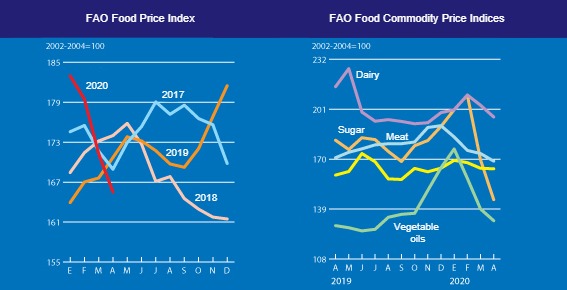World food commodity prices declined for the third month in a row during April, as the economic and logistical impacts of the COVID-19 pandemic resulted in significant contractions in demand for many commodities.
The FAO Food Price Index averaged 165.5 points in April, some 3.4% lower than the previous month and 3% lower than April 2019. Except the cereal sub-index, which declined only slightly, all the other sub-indices of the overall Index registered significant month-on-month declines in April, in particular the sugar sub-index.

The FAO Meat Price index declined 2.7% and averaged 168.8 points, registering the fourth consecutive monthly decline. International quotations for all meat types represented in the index fell, as a partial recovery in import demand, mainly in China, was insufficient to balance a slump in imports from other countries, caused by continued COVID-19 related economic hardship, logistical bottlenecks and a steep fall in demand from the food services sector due to lockdowns. Notwithstanding reduced levels of meat processing as labour shortages mounted, plummetting restaurant sales led to increased stock build up and export availabilities, also weighing on meat price quotations.
Furthermore, the FAO Vegetable Oil Price Index declined 5.2% in April, driven lower by falling palm, soy and rapeseed oil values. Reduced biofuel demand played a role, as did declining demand from the food sector along with higher-than-previously expected palm oil output in Malaysia and soy crushings in the United States of America.
The FAO Cereal Price Index declined only marginally, as international prices of wheat and rice rose significantly while those of maize dropped sharply. International rice prices rose by 7.2% from March, due in large part to temporary export restrictions by Viet Nam that were subsequently repealed, while wheat prices rose by 2.5% amid reports of a quick fulfillment of the export quota from the Russian Federation. Prices of coarse grains, including maize, by contrast fell by 10%, driven down by reduced demand for its use for both animal feed and biofuel production.

May 7, 2020/ FAO.
http://www.fao.org





